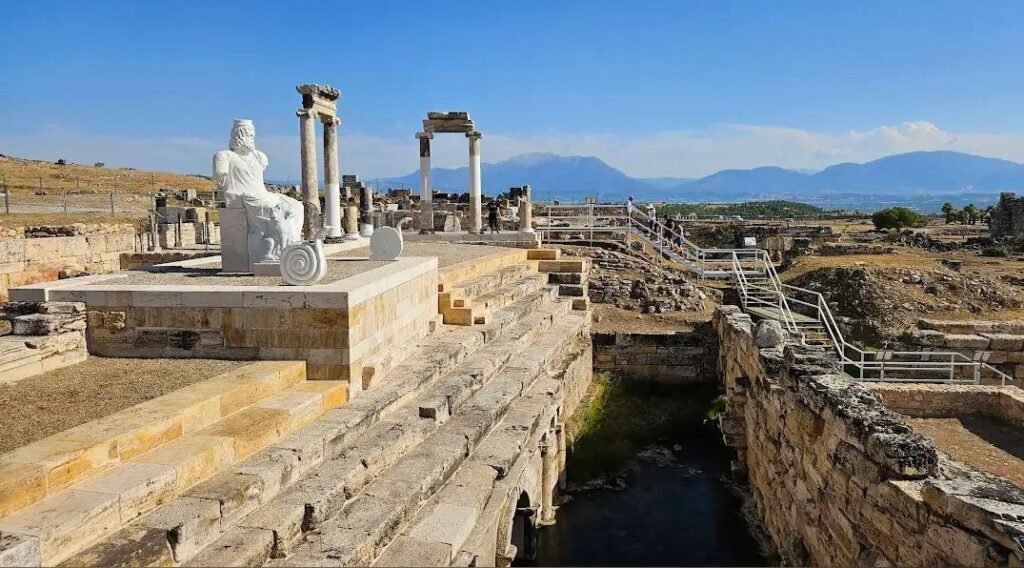Description
The Ancient City of Hierapolis: A Jewel of Pamukkale
Nestled in the heart of modern-day Turkey, the Ancient City of Hierapolis is a mesmerizing blend of history, culture, and natural beauty. Located in Pamukkale, Denizli Province, this UNESCO World Heritage Site is an essential destination for history enthusiasts and nature lovers alike. Hierapolis is not just a city of ruins; it’s a gateway to understanding the lives of ancient civilizations and their connection to the breathtaking travertine terraces of Pamukkale.
A Historical Overview
Hierapolis, which translates to "sacred city," was founded in the 2nd century BCE by the Attalid kings of Pergamon. Later, it became part of the Roman Empire and flourished as a major cultural and religious center. The city was known for its thermal springs, which were believed to have healing properties. These springs not only attracted settlers and visitors but also contributed to the city's prosperity.
During the Byzantine period, Hierapolis evolved into a significant Christian hub. The Apostle Philip was believed to have been martyred here, and a monumental martyrium dedicated to him still stands as a testament to the city's religious significance.
Despite being ravaged by earthquakes over the centuries, Hierapolis remains a treasure trove of ancient architecture, art, and inscriptions, offering a glimpse into its storied past.
The Travertine Terraces of Pamukkale
One of the most striking features of Hierapolis is its proximity to Pamukkale, meaning "Cotton Castle" in Turkish. These dazzling white terraces are formed by the calcium-rich thermal waters that cascade down the hillside, creating a surreal landscape of natural pools and travertine formations. The mineral-rich waters have been used for therapeutic purposes for over two millennia, attracting visitors seeking rejuvenation and relaxation.
The harmonious coexistence of Hierapolis’ ancient ruins and Pamukkale’s natural wonders makes this destination truly unique. Visitors can walk barefoot on designated pathways across the terraces, immersing themselves in the soothing waters while marveling at the views of the ancient city.
Key Attractions in Hierapolis
1. The Theatre
The grand Roman Theatre of Hierapolis is a marvel of ancient engineering and artistry. Built in the 2nd century CE, it could accommodate up to 15,000 spectators and was used for gladiatorial games, concerts, and theatrical performances. The well-preserved structure boasts intricate reliefs depicting mythological scenes and serves as a reminder of the city’s cultural vibrancy.
2. The Necropolis
The Necropolis of Hierapolis, one of the largest and best-preserved ancient cemeteries in Turkey, stretches over two kilometers. It contains over 1,200 tombs and sarcophagi, ranging from simple graves to elaborate family mausoleums. This vast burial ground reflects the diverse cultural and religious practices of the city’s inhabitants over the centuries.
3. The Temple of Apollo
Dedicated to Apollo, the patron deity of Hierapolis, this temple was a focal point of religious activity. Though partially ruined, the site retains its mystical allure, especially with its proximity to the Plutonium, an ancient cave believed to be an entrance to the underworld. The fumes emitted from the cave were thought to be deadly, adding an air of mystery to the temple complex.
4. The Martyrium of St. Philip
The Martyrium of St. Philip is a remarkable octagonal structure built to honor the Christian apostle. It is believed to mark the site of his martyrdom and burial. The location offers panoramic views of the surrounding landscape, adding to the spiritual and historical significance of the site.
5. The Ancient Pool (Cleopatra’s Pool)
Known as Cleopatra’s Pool, this ancient thermal pool is a favorite among visitors. Filled with warm, mineral-rich waters and surrounded by submerged columns and ruins, it’s an extraordinary experience to swim in a pool once favored by the ancients. Legend has it that Cleopatra herself bathed here, lending the site an air of romance and intrigue.
Modern-Day Pamukkale
Today, Hierapolis and Pamukkale together form a key tourism hub in Turkey. Efforts have been made to preserve the site’s historical and natural integrity while accommodating the influx of visitors. The area is equipped with modern amenities, including cafes, museums, and guided tours, ensuring a comfortable and enriching experience for all.
The on-site Hierapolis Archaeology Museum, housed in a former Roman bath, displays artifacts unearthed from the region, including statues, sarcophagi, and intricate mosaics. These exhibits provide deeper insights into the daily lives and artistic achievements of the ancient inhabitants.
Tips for Visitors
- Best Time to Visit: Spring (April to June) and autumn (September to November) are ideal for visiting, as the weather is pleasant and the site is less crowded.
- Footwear: Visitors are required to remove their shoes while walking on the travertine terraces to protect the delicate formations.
- Stay Hydrated: The area can get quite sunny, so bring water and wear sunscreen.
- Guided Tours: Opting for a guided tour can enrich your experience, as guides provide detailed historical and cultural context.
- Respect the Site: Follow designated pathways and avoid touching or damaging the ruins to help preserve this invaluable heritage.
Why Visit Hierapolis and Pamukkale?
The Ancient City of Hierapolis, combined with the surreal beauty of Pamukkale, offers a once-in-a-lifetime experience. It’s a place where history meets nature, where ancient architecture coexists with breathtaking landscapes. Whether you’re exploring the ruins, soaking in the thermal waters, or simply marveling at the unique geography, Hierapolis promises memories that will last a lifetime.
In an age where modernity often overshadows history, Hierapolis stands as a testament to the enduring legacy of ancient civilizations. A visit here is not just a journey through time but also a reminder of humanity’s ability to create, adapt, and cherish the wonders of the world. If you’re planning your next adventure, let the sacred city of Hierapolis and the Cotton Castle of Pamukkale top your list.
Location
-
Pamukkale, 20280 Pamukkale/Denizli









